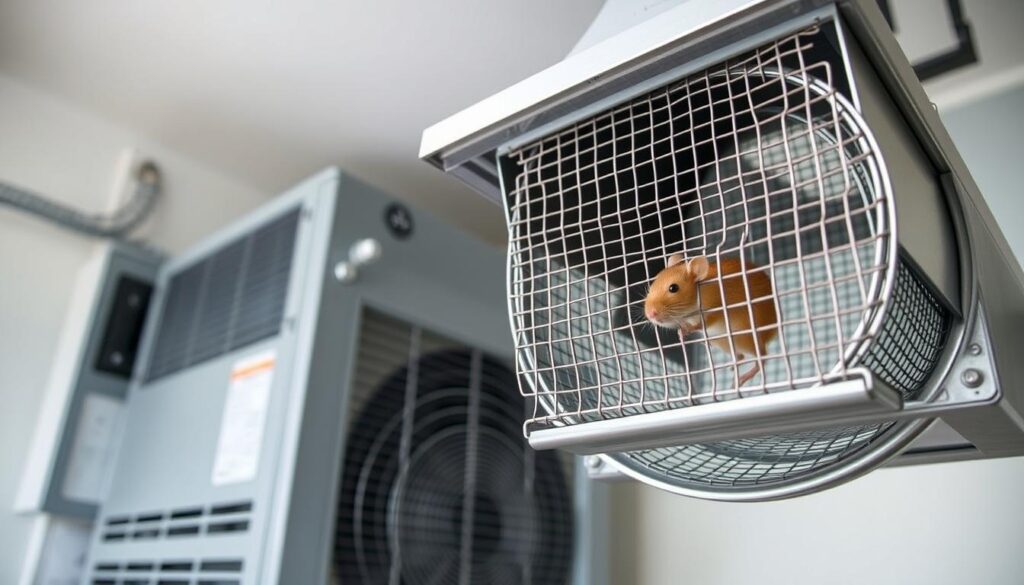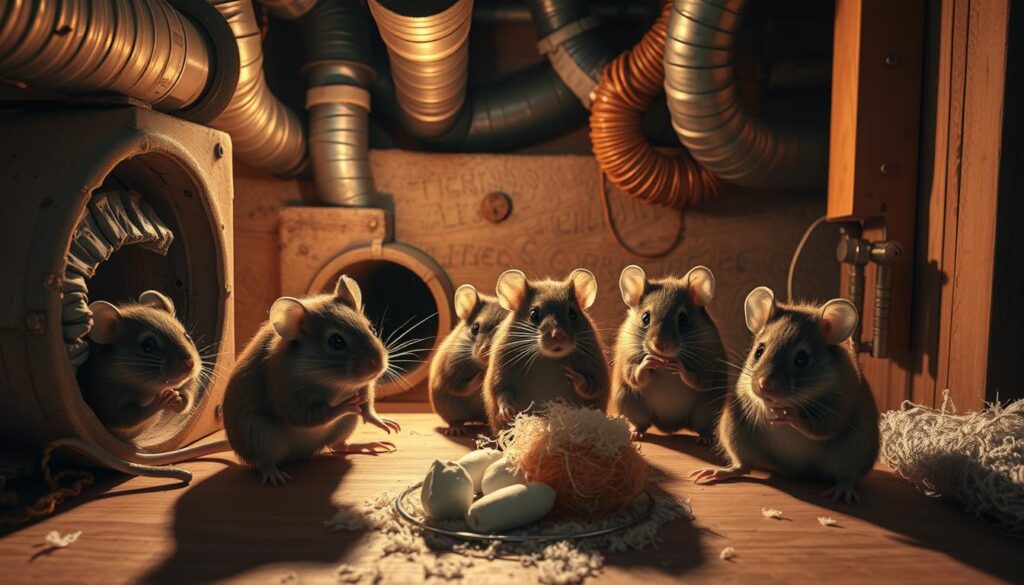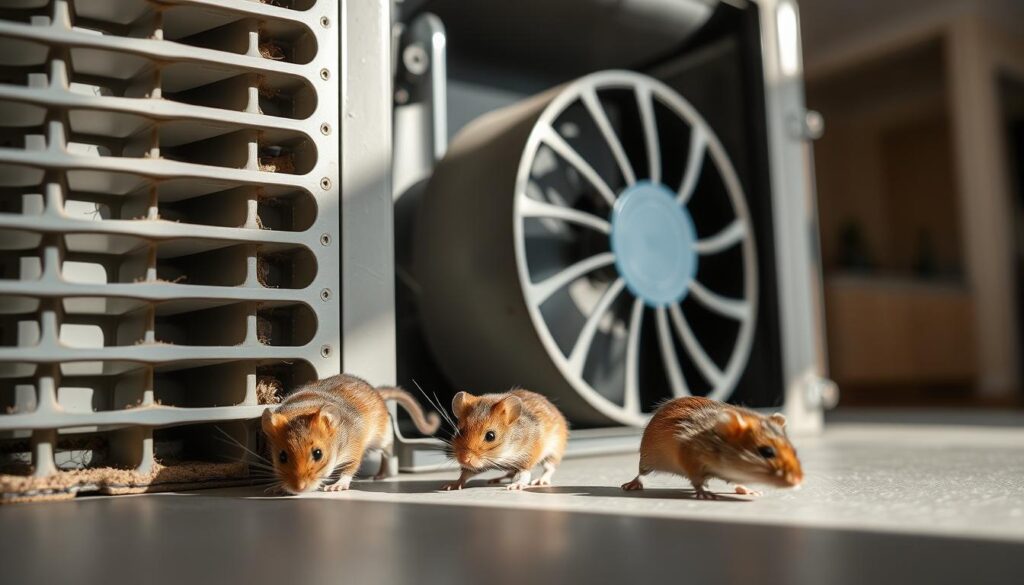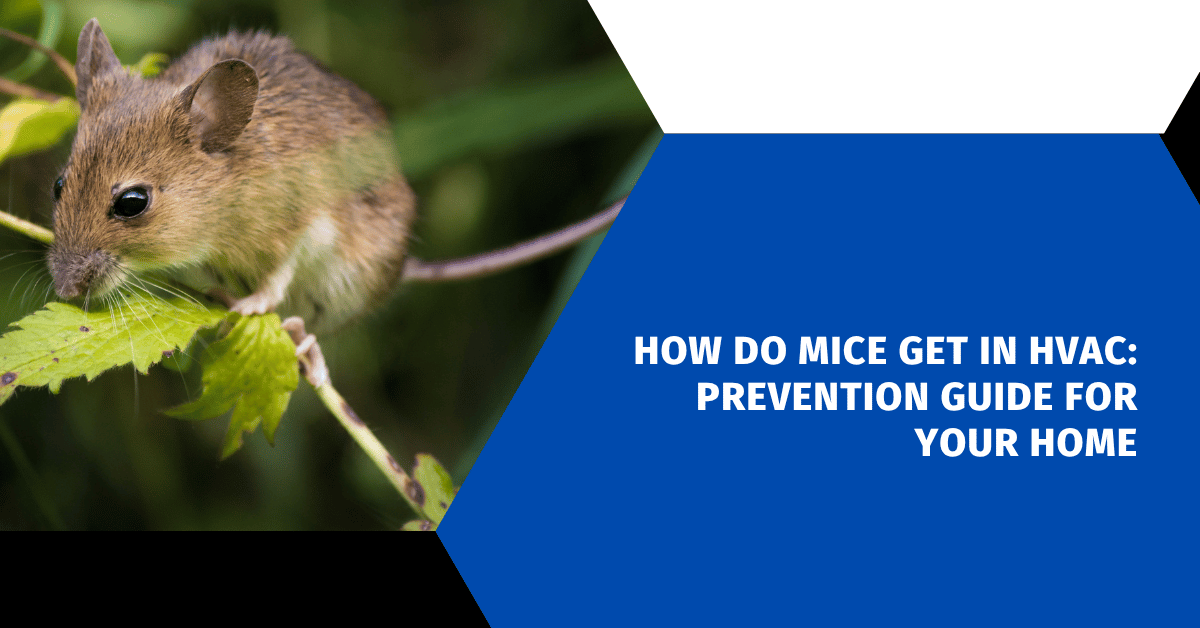Affiliate Disclosure
HVAC Guide Guys is a participant in the Amazon Services LLC Associates Program, an affiliate advertising program designed to provide a means for sites to earn advertising fees by advertising and linking to Amazon.
How Do Mice Get in HVAC? Ever thought about how mice can turn your cozy home’s air conditioning into their playground? Knowing how mice get into HVAC systems might help keep your home mouse-free.

Mice can fit through openings as small as a quarter. Your HVAC system is a cozy, warm spot for them. To stop mice in air ducts, you need to maintain your home well and control pests.
These pests love kitchens, basements, and unsealed ducts. They can sneak into attics, foundation vents, and narrow ducts. This makes stopping mice in HVAC a big deal for keeping your home healthy.
Key Takeaways
- Mice can enter through tiny openings as small as 0.25 inches
- HVAC systems provide ideal shelter for rodent infestations
- Common entry points include unsealed ducts and foundation vents
- Preventing mice requires proactive home maintenance
- Regular inspections can help detect possible rodent access points
Table of Contents
Understanding How Mice Get in HVAC Systems
Mice can sneak into your home’s HVAC system through tiny openings. These small rodents can harm your indoor air and safety. They can make it hard to get rid of them from your HVAC system.
Common Entry Points for Mice
Rodents often get into HVAC systems through:
- Gaps around pipe connections
- Loose vent covers
- Cracks in foundation walls
- Unsealed ductwork joints
- Damaged exterior vents
Why Mice Choose HVAC Systems
Mice like HVAC systems for good reasons:
- Warmth and shelter in cold weather
- Dark, safe places for nesting
- Easy way to get inside
- Less chance of being seen
Vulnerable Areas in Your HVAC
| HVAC Component | Mouse Vulnerability | Risk Level |
|---|---|---|
| Air Ducts | High accessibility | Critical |
| Attic Connections | Easy entry points | High |
| Basement Vents | Potential nesting areas | Moderate |
“A mouse can squeeze through a hole as small as ¼ inch in diameter, making most HVAC systems vulnerable to invasion.” – Pest Control Expert
Knowing where mice can get in helps you keep your HVAC safe. You can then plan how to keep them out.
Explore Our HVAC Shop
Looking for top-rated HVAC tools, parts, and accessories? Visit our shop and find the perfect solution for your needs.
Visit the ShopSigns of Mouse Infestation in Your Ductwork
Finding mice in your HVAC system early can prevent health risks and costly repairs. Look for mouse droppings in air vents, which are small, dark pellets that look like black rice. They are a clear sign of a rodent problem in your ductwork.
Spotting mice in your HVAC unit needs careful attention. Listen for odd sounds from your vents, mainly at night. Mice are most active then, making sounds like squeaking, rustling, and scratching.
- Squeaking sounds
- Rustling movements
- Scratching within walls or ducts
A musty, ammonia smell in your vents is another warning sign. This smell comes from mouse urine, showing your HVAC system might be contaminated.
“A mouse nest is typically identifiable by tightly packed shredded materials like paper or insulation with surrounding droppings.” – Pest Control Expert
Mice can spread diseases like hantavirus and salmonellosis. Their waste and urine can spread bacteria, making your home’s air unsafe.
If you think you have mice, act fast. Look for these signs:
- Visible droppings near air vents
- Unexplained blowfly infestations
- Unusual musty odors
- Small gnaw marks around ductwork
Early detection can stop big damage and keep your family safe.
Explore Our HVAC Shop
Looking for top-rated HVAC tools, parts, and accessories? Visit our shop and find the perfect solution for your needs.
Visit the ShopHealth Risks and Property Damage from HVAC Mice
Mice in your HVAC system are a big problem. They can harm your health and damage your home. These tiny pests can cause serious issues, affecting your indoor air and possibly leading to costly repairs.
Disease Transmission Risks
Mice can spread diseases through your air ducts. This makes your HVAC system a risk for health problems. Their waste and urine carry harmful germs that can spread in your home.
- Potential diseases include lymphocytic choriomeningitis
- Salmonellosis transmission through airborne contaminants
- Increased risk of respiratory complications
Indoor Air Quality Challenges
Mice infestations can really hurt your home’s air quality. The allergens from their droppings can make allergies worse and cause breathing problems. This is a big issue for people with health issues.
“Approximately 30% of asthma patients may experience increased symptoms due to mouse-related contaminants”
Structural HVAC Damage
Mice can also damage your HVAC system. They chew on wires, insulation, and important parts. This can lead to expensive fixes and make your system less efficient.
- Potential electrical fire risks
- Compromised ductwork integrity
- Expensive system component replacements
It’s important to keep your HVAC system and home safe from mice. Regular checks and quick action can stop these pests from causing harm.
Essential Prevention Methods for HVAC Protection
Keeping your HVAC system safe from mice needs a smart plan. Rodents can get in through openings as small as 1/4 inch. So, it’s key to stop mice from getting into your air ducts to keep your home healthy.
Here are some important steps to seal off HVAC openings against mice:
- Check and seal all possible entry spots around HVAC systems
- Use steel wool and caulk to block small gaps
- Put fine-mesh screens on vents and openings
- Keep the area around your HVAC unit clean
“A proactive approach can reduce rodent attraction by up to 50%”
Experts say to seal any gaps bigger than a dime. This simple action can greatly lower the chance of mice getting into your HVAC system. Regular maintenance is your first line of defense against rodents.
Here are more ways to protect your HVAC system:
- Trim plants near your HVAC unit
- Remove any food that might attract pests
- Try natural pest repellents
- Do quarterly checks
By using these prevention methods, you’ll keep your HVAC system safe from mice. This protects your home’s structure and the air you breathe indoors.
Explore Our HVAC Shop
Looking for top-rated HVAC tools, parts, and accessories? Visit our shop and find the perfect solution for your needs.
Visit the ShopProfessional vs DIY Mouse Removal Approaches
Dealing with mice in your HVAC system needs a smart plan. Knowing when to handle it yourself and when to call experts can save you time, money, and health risks.
Deciding Between Professional and DIY Solutions
Mice in HVAC systems are tricky. Experts in pest control have skills DIY methods can’t match. Think about these points when deciding:
- How big the infestation is
- How easy it is to get to the affected areas
- Your own technical abilities
- How much you can spend
When to Call an Expert
It’s time to call a pro for mice removal in certain situations:
- When mice are everywhere in your system
- If mice have damaged your HVAC parts a lot
- If there’s a big health risk from all the mouse mess
- If finding where mice get in is really hard
Safe DIY Removal Techniques
For small mouse problems, you can try these safe methods:
- Set up snap traps in key spots
- Block off where mice might get in
- Try using natural mouse repellents like peppermint oil
- Keep your place clean and tidy
Cost Considerations
| Approach | Average Cost | Effectiveness |
|---|---|---|
| DIY Methods | $50-$200 | 50-60% |
| Professional Services | $250-$600 | 80-90% |
“Prevention is always more cost-effective than extensive repairs caused by unchecked mouse infestations.”
Professional mice removal hvac services offer complete solutions for both now and the future.
Sealing and Securing Your HVAC System
Keeping mice out of your home starts with sealing HVAC openings. Mice can fit through tiny gaps, even as small as a quarter-inch. So, sealing these openings is key to home maintenance.

To seal effectively, you need a solid plan. Here are some important steps:
- Inspect all HVAC system entry points carefully
- Use the right sealing materials
- Choose solutions that keep mice out
- Check your system regularly
For top-notch sealing, use professional-grade materials. Here are some good choices:
| Sealing Material | Effectiveness | Best Used For |
|---|---|---|
| Steel Wool | High | Large gaps and cracks |
| Silicone Caulk | Very High | Small openings and joints |
| Copper Wire Mesh | Excellent | Ventilation areas |
“Prevention is always more cost-effective than dealing with a full-blown rodent infestation.” – Pest Control Expert
Window screen mesh kits add extra protection for AC and heat pump systems. Make sure to get the right size to keep air flowing while keeping pests out.
Seeing one mouse might mean there are up to 20 more nearby. Regular checks and sealing can prevent big problems and health risks.
Explore Our HVAC Shop
Looking for top-rated HVAC tools, parts, and accessories? Visit our shop and find the perfect solution for your needs.
Visit the ShopCleaning and Sanitizing After Mouse Removal
Removing mice from your HVAC system is just the first step. Cleaning and sanitizing your home is key to keeping it safe. HVAC cleaning after mice infestation needs a careful plan to avoid health risks and stop future problems.
Cleaning your HVAC system well means following several steps. You need to pay close attention and follow safety rules.
Essential Cleaning Procedures
- Wear protective equipment: respirator, rubber gloves, and protective eyewear
- Use HEPA vacuum to remove droppings and debris
- Prepare a disinfectant solution: 1.5 cups bleach per gallon of water
- Clean hard surfaces with EPA-approved disinfectants
- Allow disinfectant to sit for 5-10 minutes before wiping
Recommended Sanitization Methods
The CDC says wet cleaning is best to avoid spreading dangerous particles. Avoid dry sweeping or vacuuming rodent waste, as it can spread harmful germs in the air.
“Proper sanitization is not just about cleaning, but protecting your health from possible rodent-borne diseases.”
Preventing Future Contamination
- Seal all possible entry points in your HVAC system
- Install mesh screens on vents
- Do regular HVAC checks
- Keep your surroundings clean
- Think about getting professional duct cleaning every year
Remember, cleaning your HVAC system after mice is vital for a safe, healthy home. For big infestations, getting help from professionals is a good idea to make sure everything is clean.
Regular Maintenance Tips for HVAC Protection
To keep your HVAC system safe from mice, you need to stay proactive. Mice can sneak into your system through small holes. This can harm your health and damage your home’s air system.

Start by checking your HVAC system every month. Experts say this is key to stopping mice before they get in.
- Inspect outdoor AC units for signs of mouse activity
- Clear at least two feet of space around HVAC units
- Check for water leaks and standing water
- Seal possible entry points with mesh screens
*”Prevention is always more cost-effective than dealing with a full-blown mouse infestation”*
Keeping your yard clean is also important. About half of pest problems come from plants and debris near HVAC systems. Keeping your yard tidy can help keep mice away.
Calling a professional can really help. They can cut mouse problems in HVAC systems by up to 90%. While you can try DIY fixes, some problems need expert help.
| Maintenance Task | Frequency | Pest Reduction Percent |
|---|---|---|
| Perimeter Cleaning | Monthly | 50% |
| Mesh Screen Installation | Annually | 75% |
| Professional Inspection | Bi-Annually | 90% |
By following these maintenance tips, you can greatly lower the chance of mice getting into your HVAC system. This will help keep your home’s air and structure safe.
Explore Our HVAC Shop
Looking for top-rated HVAC tools, parts, and accessories? Visit our shop and find the perfect solution for your needs.
Visit the ShopLegal Considerations and Property Owner Responsibilities
Property owners must understand their legal duties in hvac maintenance and mice control. The law requires them to manage pests to keep tenants safe and the property in good shape.
Property owners have big legal duties when dealing with mice in HVAC systems. Important legal points include:
- Maintaining a safe living space
- Quickly handling pest problems
- Stopping health dangers from rodents
- Following local health and safety rules
“Ignoring pest control can lead to big legal and financial problems for property owners.”
Some stats show how important pest control is in property management:
- 25% of homes deal with pests every year
- Mice can get in through openings as small as 1/4 inch
- Good HVAC care can cut rodent problems by up to 50%
- Property owners might have to pay $5,000 in legal fees for pest issues
Knowing about hvac maintenance and its risks is key. Acting early on pest control can lower legal risks and keep property value and tenant health up.
Property owners should focus on:
- Regular checks on the HVAC system
- Quick action when pests are found
- Keeping records of maintenance
- Telling tenants clearly about what’s happening
By using strong mice control and keeping HVAC systems well-maintained, property owners can avoid legal trouble. They can also make sure their places are safe and healthy for everyone.
Conclusion
It’s important to know how mice get into HVAC systems to keep your home safe. Rodents can harm your health and damage your home. They can also make your indoor air dirty.
To stop mice in air ducts, you need to do a few things. First, keep your HVAC system clean and check it often. Also, seal any holes where mice could get in. This will help a lot.
Experts say you should use a few methods to keep mice out. Clean your ducts well, seal small holes, and check your vents often. Mice can squeeze through tiny spaces, so you must be careful.
Keeping your home clean and watching for mice signs is key. Act fast if you see any mice. This way, you can keep your air system clean and your home healthy.

